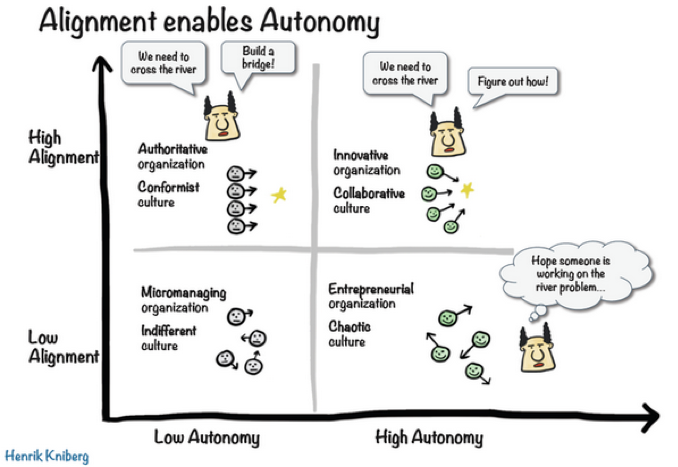Agile teams are known to be autonomous and self-organizing.
When I started fostering agility and encouraging autonomy and self-organization for the teams I work with, It was only normal to to face a situation where teams decided to do things their way, under the name of autonomy and self-organization.
The problem was that the direction they were heading in was not going to lead to the collective success of the enterprise.
My role was to help them succeed, thus I had the challenge of directing them while helping them improve their agility and thus their autonomy and self organization.
Is that an impossible equation to solve ?
If you’re new to agility you might think that this a proof that agility fails in an enterprise context and is only meant for a small team.
Fortunately it’s not the case, agility, when well understood and applied, works at scale and delivers its promises.
Autonomy of agile teams is a must but it’s not sufficient, along that, teams in an enterprise context need alignment.
Autonomy without alignment will only lead to anarchy, and this is something you don’t want. Anarchy rarely leads to success.
Only when both alignment and autonomy are present, agile teams can become successful.
This is greatly illustrated by Henrik Kniberg in the “Spotify Engineering Culture” and several of this talks.
- Down here is low alignment and low autonomy. Micromanagement Culture, no high level purpose just shut up and follow orders.
- Up here is high Alignment, but low autonomy. So leaders are good communicating what problems needs to be solved, but also they are telling people how to solve it.
- High Alignment and High Autonomy means leaders focus on what problems to solve but let the teams figure out how to solve it
- What about down here then? Low alignment and high autonomy. Means teams do whatever they want…
But how do teams get alignment ?
As alignment aim to make several teams work toward the same goals, it’s by design an external factor to the teams.
Thus the teams can’t achieve alignment on their own.
Agile managers are still an important piece of the puzzle, and fit naturally in the agile context.
By helping teams getting alignment, they provide them with one of the necessary ingredients for their success.
I work in a fast-paced and constantly changing work environment, with geographically dispersed and culturally diverse teams, reaching alignment in such context is not an easy task.
As an agile manager I need to constantly drive alignment, in order to allow autonomy to build. It’s about keeping the people and the work progressing in the correct direction toward to the goals, and it’s not to be confused by staying “on plan”.
To accomplish this I practice consistently communicated, measurable, incremental goals.
In my next post I’ll explain one of the tools I use to bring that guidance to the agile teams.

